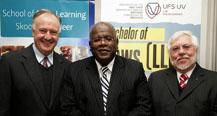 |
At the event were, from the left: Mr Frank Thompson, CEO of ADvTECH, Prof. Jonathan Jansen, Vice-Chancellor and Rector of the UFS, and Prof. Johan Henning, Dean of the Faculty of Law at the UFS.
Photo: Johan Roux
30 July 2012 |
The University of the Free State (UFS) and Varsity College this week officially launched a partnership whereby the university’s Faculty of Law will offer a four-year Bachelor of Law qualification through the UFS School of Open Learning on eight Varsity College campuses nationwide. This new degree will be offered as early as 2013.
This is the fulfilment of a dream, said Prof. Johan Henning, Dean of the Faculty of Law at the university. He was one of the speakers at the event that was attended by staff members and management from the, Faculty of Law, the university’s South Campus, Varsity College and ADvTECH.
The UFS Faculty of Law is one of the oldest and most distinguished faculties of law in South Africa, and has a close association with several overseas universities which ensures that the institution is internationally recognised.
“I am very positive and enthusiastic about this new partnership. We want to make this an enriching experience for staff and students from both the university as well as Varsity College,” Prof. Henning said.
The CEO of ADvTECH, Mr Frank Thompson, said he is overjoyed about the project and its potential. Varsity College is a brand of the ADvTECH Group, a JSE listed company invested in human capital.
“This is a new beginning for Varsity College and the UFS. Learning together, the slogan for this project, is very appropriate. We are excited to add new students to the university and Varsity College’s line-up,” Mr Thompson said.
Varsity College is part of the Independent Institute of Education (IIE), the leading provider of private higher education in South Africa. According to Dr Felicity Coughlan, Director of the IIE, the partnership between the IIE and the university is an example of the potential that is inherent in public-private partnerships to increase the range of high quality options available to students.
Prof. Jonathan Jansen, Vice-Chancellor and Rector of the UFS, who also was one of the speakers at this event, said with this partnership, students will get the best of both worlds in accessing higher education.
The Faculty of Law will ensure that students obtain both a thorough grounding in legal theory, as well as a solid practical foundation, and Varsity College, through a strong commitment to innovative teaching and learning, will empower more students to become legal graduates of the highest calibre. Thus, the innovative partnership between the UFS and Varsity College will produce a Bachelor of Law degree that is highly sought after in the legal profession.
This partnership is the first of its kind, paving the way for increased collaboration between public and private tertiary institutions to best serve the education sector and the future of graduates.
“This is what is possible when two dynamic partners like the university and Varsity College come together,” Prof. Jansen said.